|
By Peter Kleinhenz
Recently, I was at a local bar shooting aliens.
They just kept coming, rows and rows of them, dropping bombs while I tried to
pick them off with one puny laser after another. I had a good run for a while,
until the speed at which they descended upon me increased to the point where I
no longer stood a chance. My defenses were destroyed. My fingers were tired.
Those aliens bombed me into obliteration.
Before
you make too many assumptions about my sanity, or how it’s possible that I’m
writing from beyond the grave, I should explain. I spent Halloween night
playing old-school arcade games with a friend. We dumped our tokens into Space
Invaders, a game only surpassed by Centipede in its ability to aggravate. I
found myself swearing at the machine, frustrated by the futility of it all. I
never did get past the first level, but the game at least got some wheels
turning in my head.
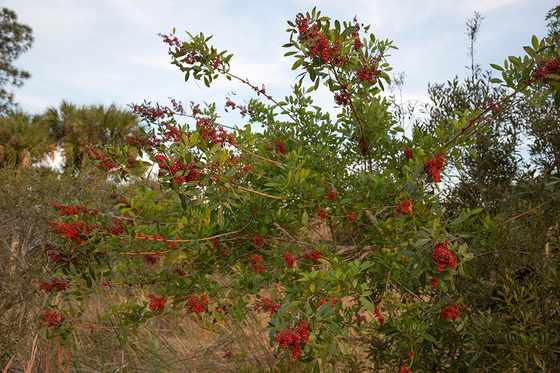 Invasive Brazilian pepper at Okaloacoochee Slough Wildlife Management Area, photo by David Moynahan
I realized that this 1980s throwback serves as a perfect
analogy for the real war we wage on invasive species here in Florida every day.
Invasive species are not native and are causing, or are thought to have the
potential to cause, harm to native ecosystems. Like the rows of aliens in Space
Invaders, invasive plants and animals seem to just keep coming no matter how
many we eliminate. And, like the token-slurping arcade game, the fight against
invasive species will cost a great deal of time and resources if we ever hope
to win.
Invasive
species closely follow habitat loss as a leading cause of extinction. They cost
huge amounts of money to control. In some cases, they are downright dangerous. To
put it simply, they’re bad news. The Florida Fish and Wildlife Conservation
Commission (FWC) aggressively targets invasive species as part of its overall
management of wildlife habitat in Florida. This is especially true in South
Florida, a region appropriate to describe as the front line in the war on
invasive species here in the Eastern United States.
 Managing invasive species helps us preserve habitats, photo by David Moynahan
J.W. Corbett Wildlife Management Area (WMA) occupies
60,478 acres in Palm Beach County, Florida. Invasive species seem to creep in
from all directions there, resulting in an uphill battle in the larger war. Carrie
Black, the lead area biologist for J.W. Corbett WMA who oversees its
management, took some time with me to explain why and how this battle gets
fought.
“The
problem with invasives is that they’re exploiting resources that native
species require for their survival because no natural enemies exist to keep the
number of invasives in check,” Carrie told me over the phone. “If there’s some
disturbance in the environment, [invasive] plants are well-adapted to come in
and take over. Open spaces are very important for our native plants and
animals, and Florida is a fire-adapted ecosystem. Typically, the pine flatwoods,
which is one of the most common communities in Florida, would burn every two to
three years. That creates a very open environment. When these exotics come in,
they create dense [stands], they don’t behave the same way that native plants
do to fire, and they really take up valuable habitat, places that other animals
would use either for housing or, in some cases, for food.”
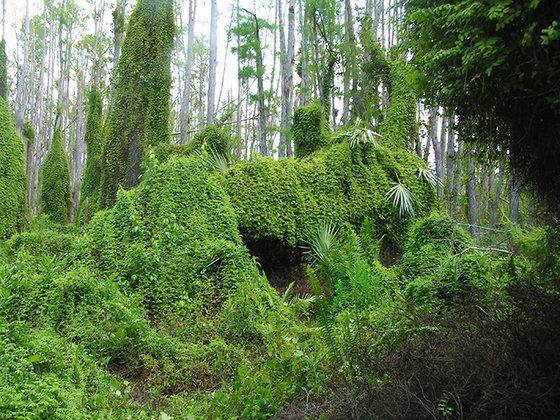 Old World climbing fern, shown here before treatment at J.W. Corbett WMA, can completely overwhelm native species, FWC photo
A question that came to mind early in the conversation
was how it was possible to make even a dent on 60,000-plus acres of invaded
land. The answer is two-fold: have your own invasive species biologist and hire
contractors to cover as much ground as possible. At J.W. Corbett WMA, the two
work in tandem to ensure that the issue is, quite literally, nipped in the bud.
“The
contractors we hire are required to cover 100 percent of their treatment area,”
Carrie described. “The crewmembers carry GPS units to record their tracks, and [J.W.
Corbett WMA staff] use the tracks to monitor their treatment progress and single
out hotspots or gaps to visit during compliance inspections. Sarah Huber, our invasive
species biologist, downloads the tracks from their GPS units and puts them up
on the computer so she can see where the contractors treated. Generally, the
crewmembers are evenly spaced out, sweeping the area; but when they encounter a
hotspot, they call to each other and everyone goes to the hotspot and treats
the area before moving on. If there are no tracks, it is considered a gap and
Sarah can target those areas, as well as hotspots, in the field to ensure the
contractors didn’t miss any areas and achieved the control rates of their
contract."
 Workers treat invasive plants at J.W. Corbett WMA, FWC photo
The
nature of the problem necessitates these high-tech practices. Species such as
Old World climbing fern and Brazilian pepper thrive in South Florida’s warm,
wet conditions. They grow fast and reproduce prolifically. A single Old World
climbing fern leaflet, for example, can produce over 28,000 spores that,
individually, have the potential to start a new population. Contractors treat
the invasive plants with herbicides designed to both specifically target plants
and to break down quickly in the environment. According to Carrie, however,
truly managing invasive species on our wildlife management areas requires a
more holistic approach.
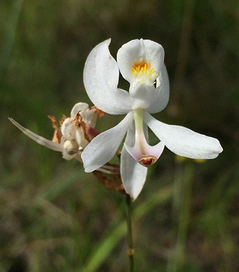 |
|
“In
a healthy ecosystem, in general, all the niches are filled and the species
living there are in balance with one another. Those ecosystems are very
resilient. And so, another strategy is just to keep the ecosystem healthy. [We
try] to keep the recommended burn interval, to make sure the hydrology is in
tune with what it was historically. Those things create a healthier ecosystem
and, in time, they make it harder for invasives to actually get a foothold.” |
Managing invasive plants benefits native species such as this orchid, photo by Joshua Spall
In other words, we can (and should) eradicate invasive
species directly, but we also need to recognize that the threats will keep
coming and that resilience to those threats is key. Wildlife management areas,
then, serve as an advantageous battlefield in which to wage the war against
these species.
“I
think controlling invasives is about preserving unique habitats, and that
there’s an economic and an aesthetic value to that,” Carrie noted.
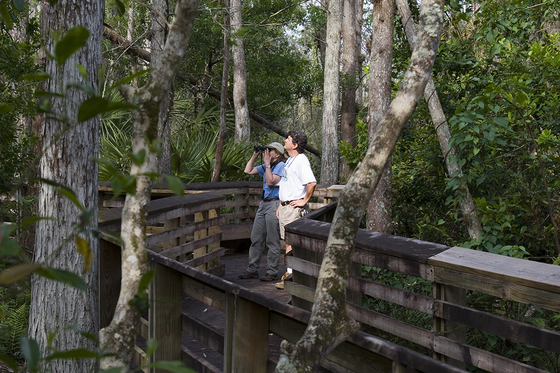 Controlling invasive species helps provide better experiences for visitors, photo by David Moynahan
The work conducted at J.W.
Corbett WMA exemplifies this. The staff there are causing the oncoming march of
invasive species to slow and, in some cases, retreat due to their habitat
management. The experiences available to wildlife viewers, hunters, anglers and
all others who enjoy recreating there continue to improve. And, while the
threats from invasives in South Florida seem especially pronounced, the same
improvements can be seen in practically all other Florida WMAs.
Carrie and her staff still have their work cut
out for them in terms of controlling invasives in their corner of the state.
However, I felt encouraged by the end of our phone call. It was clear that
Carrie was dedicated to this effort, and more than just as an FWC employee. It
was obvious that the fight against invasive species mattered to her on a
personal level.
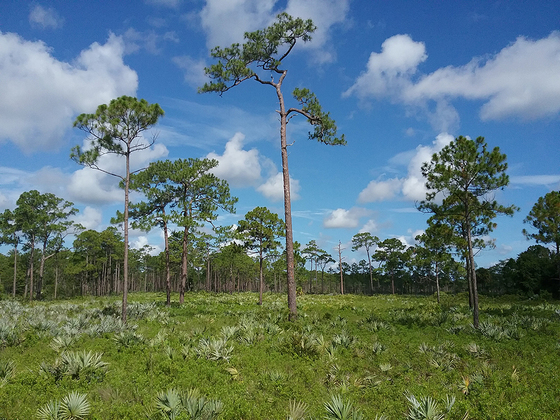 Healthy pine flatwoods community at J.W. Corbett WMA, photo by Paul Miles
“It’s easy to grow accustomed to
the beauty right outside our windows,” Carrie explained. “It happens to me all
the time at Corbett. It takes a comment from a friend or family member I bring
out with me to make me remember what a special place this is. Part of the magic
of the WMA system is that each management area is different. Every time I visit
a new WMA, I’m blown away by how beautiful they all are. It makes me appreciate
where I’m at and what I have at home. Invasives have the potential to change
that.”
I don’t know how FWC biologists like Carrie
maintain their motivation and optimism in terms of the real-life invaders of
our natural spaces, but I’m sure glad that they do. As for me, I heard about an
invasive plant pull coming up in a park near my neighborhood. That’s probably a
more worthwhile endeavor than a quest to get my initials on a high score
screen. Besides, it doesn’t cost any tokens.
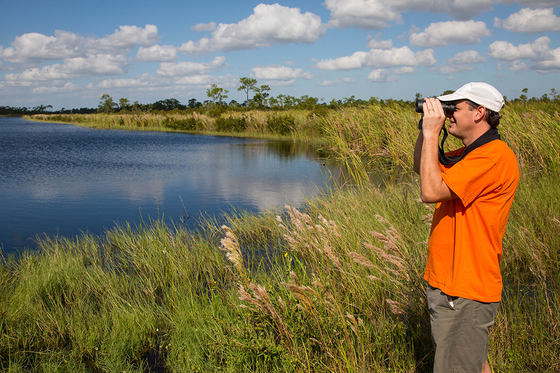 A wildlife viewer enjoys the managed habitat at Jones/Hungryland WEA, photo by David Moynahan
Would
you like to play a role in invasive plant management? Check our
list of events to find an invasive species workday near you. Each of you
can help FWC better understand the distribution of invasive species by
downloading the FWC
Reporter App, participating in Florida
Nature Trackers and/or by downloading the IveGot1 app. To see the
benefits of invasive species management, visit a WMA near you.
See you out there!
|